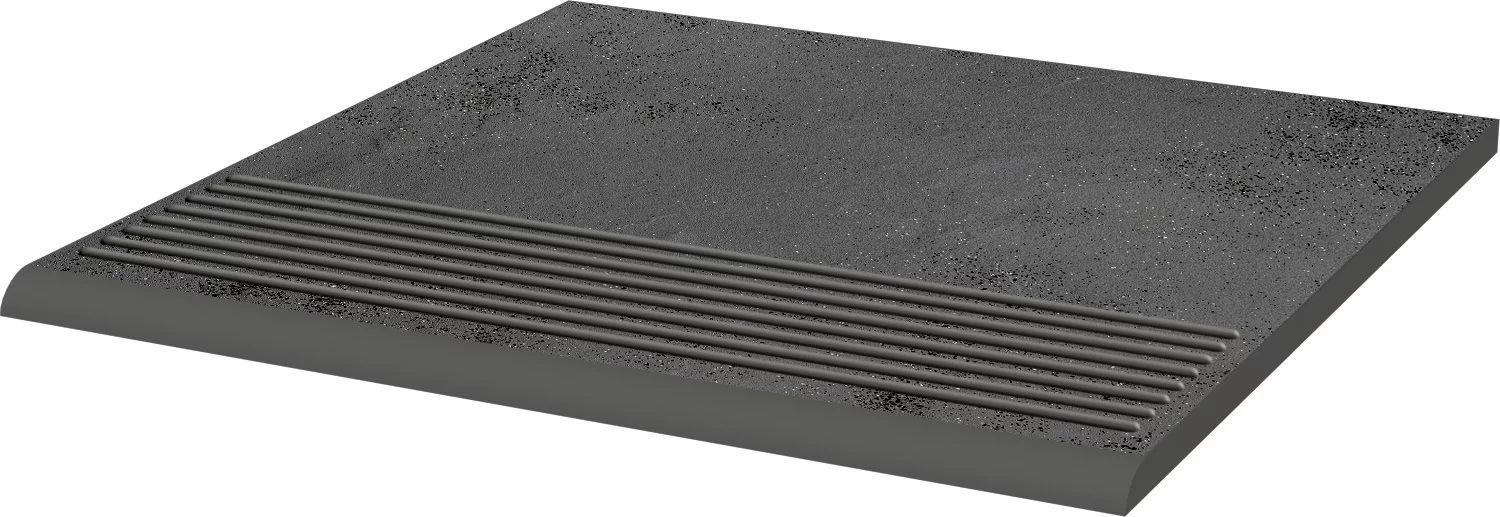If you are planning to install ceramic tiles in your home, whether on the wall or on the floor, it is advisable to first familiarise yourself with the different ceramic tile solutions and their characteristics before delving into the visual side such as colour, patterns and finishes.
As far as the appearance of ceramic tiles is concerned, there is a fairly wide range of authentic designs available in natural stone, marble, wood, concrete and metal. Ceramic tiles are significantly more practical than many finishing materials, with advantages such as superior durability, easy maintenance and longevity. In addition, ceramic tiles make it significantly easier to combine different sizes and patterns.
Ceramic tiles are one of the best choices for flooring in both public and residential spaces in terms of durability, maintenance and daily cleaning.
Different types of ceramic tiles.
1. Ceramic tiles.
1.1. Ceramic tiles are made from a mixture of clay, sand, feldspar, quartz and water. This mixture is dried to a powder, pressed under high pressure and then fired at temperatures between 1000 and 1300 degrees Celsius, depending on the type of tile. The basic colour of the tiles, whether white or red, depends on the clay used to produce them, i.e. whether white or red clay has been used to produce the tile.
Although most ceramic tiles are primarily intended for wall tiling due to their softer and more porous nature, which makes them susceptible to cracking, chipping and staining, there are also more durable floor tile solutions. However, they are only intended for indoor use as their high water absorption (above 4%) makes them unsuitable for outdoor use. Ceramic tiles offer a wide range of formats, colours and designs, and are relatively easy to cut and drill holes (compared to porcelain tiles). The higher quality tiles are often made from white clay, which allows the production of wall tiles of larger formats. These solutions often have cut edges to allow the tiles to be installed with minimal grouting.
Methods of production
Ceramic tiles can be manufactured using either the MONOCOTTURA or BICOTTURA method. The monocottura method, which means ‘single firing’ in Italian, is commonly used for floor tiles and involves simultaneous high temperature firing of the tile base and glaze. Historically, this method was used until 1990. Until the late 1990s, it was used for the majority of residential floor tiles.
Wall tiles are characterised by their wide range of colours and decorative finishes, which are achieved by the bicottura production method. Although the term bicottura refers to a double firing process, these tiles can also be fired more than once, depending on the number of layers of glaze applied. The firing temperatures of bicottura tiles are lower than those of monocottura tiles, as the aim is not to achieve maximum hardness but rather visual effects. The firing temperature of the tile is directly related to the hardness of the tile, i.e. the higher the temperature, the harder the tile will be.
2. Porcelain tiles (often referred to as solid tiles in Estonian).
Porcelain slabs, or solid slabs, are made from fine clay mixed with quartz and feldspar and fired at around 1300°C. The high kiln temperature changes the nature of the clay, making it a very hard material. The porcelain is virtually non-porous and resistant to scratching and possible staining. Thanks to its high density, porcelain tiles have a water absorption of less than 0,5 %, an important property for outdoor use.
Porcelain tiles are an excellent choice for use in high-traffic areas. Porcelain tiles are also an ideal solution for use on the kitchen floor, as they do not require additional protection against possible stains and are a fairly easy-to-clean material. Most porcelain tiles are between 8 and 11.5 mm thick, but there are also newer thinner resilient tiles that can be as little as 3 mm thick. The main advantage of these thin tiles is the ease of installation. These tiles can be quickly installed on top of existing tiles without having to take up the original tiles, avoiding time-consuming and dusty demolition work. They are very easy to cut and drill. The 3 mm thickness also ensures a smaller ecological footprint, as only about a third of the material used in conventional tiles is used in production.
The innovative high-resolution digital ink-jet printing technology used in the production of the slabs enables the production of slabs that are indistinguishable from natural stone or wood. The ink-jet technology also excels at creating textured surfaces. The technology can also be used to produce different styles of patterns.
Difference between glazed and unglazed porcelain tiles
Generally speaking, porcelain tiles can be divided into two groups in terms of their finish: glazed and unglazed tiles.
Unglazed porcelain tiles, also known as through tiles.
Unglazed porcelain tiles are produced from a mixture of different raw materials, including clay, quartz, silica and feldspar, which, when fired, form a porcelain tile with a uniform shade and characteristics. The result is a slab with a natural stone design running through it, with no glaze on the surface. The unglazed slab has a design that runs through the entire slab from the surface to the bottom. In addition to the design, the technical properties of the tile, such as water resistance, frost resistance and acid resistance, are the same throughout the tile. In the past, the designs of this solution were limited, but new high-resolution printing technologies allow the production of sophisticated designs also for unglazed through tiles
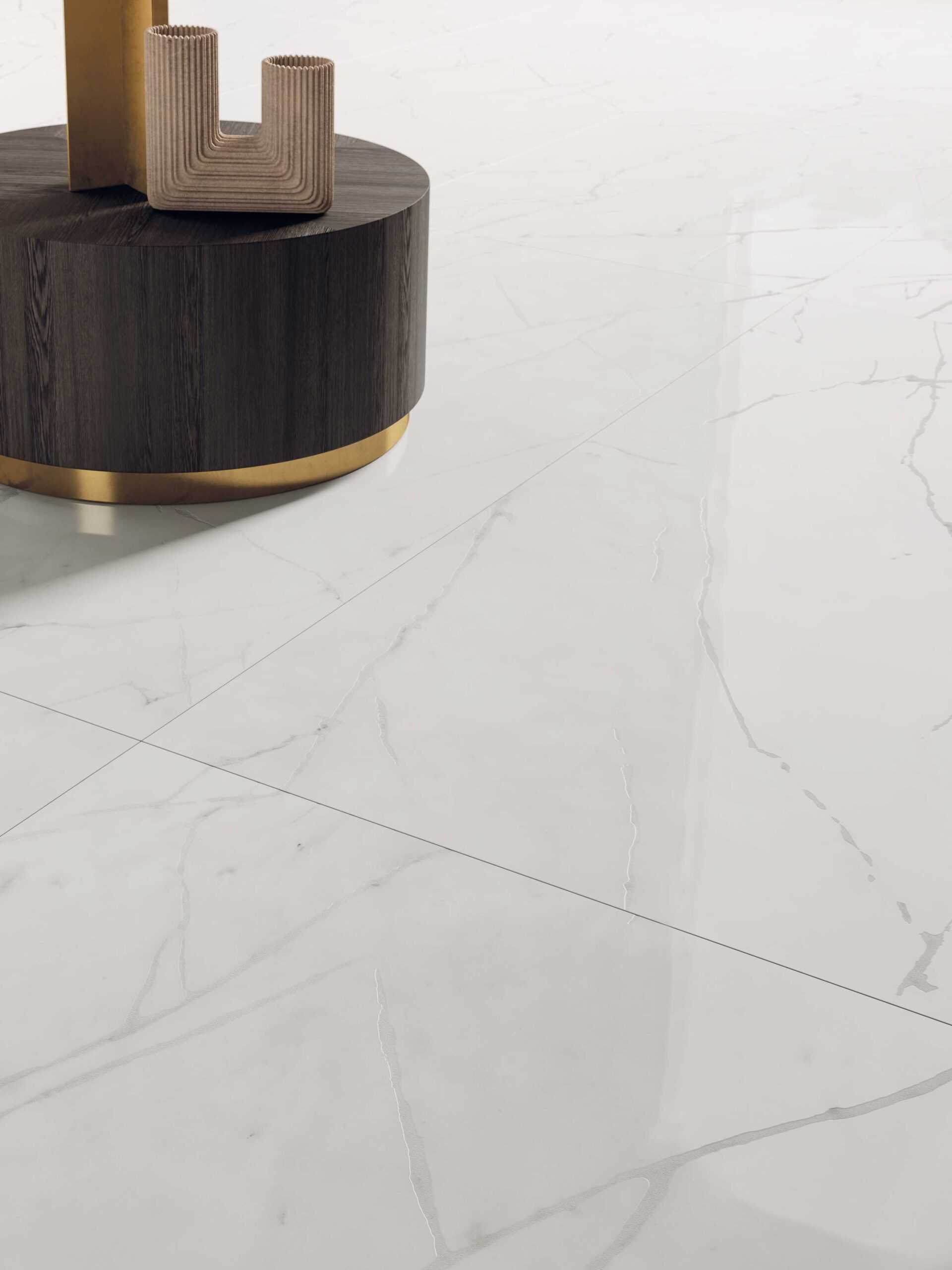
Pictured ABK Sensi 900 Carrara Soft antique with innovative 3D technology
Polished unglazed through tile
Polished through tile is a porcelain tile with a glossy surface and no glaze. It is an unglazed tile that has been mechanically polished to a glossy sheen, in a similar way to natural marble or granite tiles. And, just as polished marble or granite tiles require impregnation to prevent possible staining, so does a polished slab. Polishing a slab changes its absorbency. Porcelain with a slightly textured natural/matte surface will not absorb dirt and stains will not form.
Mechanical polishing makes the surface of the through-plate smooth and opens up the micro-pores in the plate, making the surface more porous and increasing the likelihood of stains. Due to this fact, the through-plate requires impregnation (although this is already done by the manufacturer in the factory). It should also be borne in mind that polishing makes the surface of the plate quite slippery when wet. Impregnation of the polished through-plate solves the problem of stains, but not the problem of slipperiness of the wet plate. Therefore, it is recommended that polished slabs are used as flooring in areas where there is little or no possibility of the slab getting wet, or as wall tiles where there are no slipperiness problems. Matt-finished tiles are slip-resistant, but it is advisable to check the manufacturer’s slip-resistance rating.
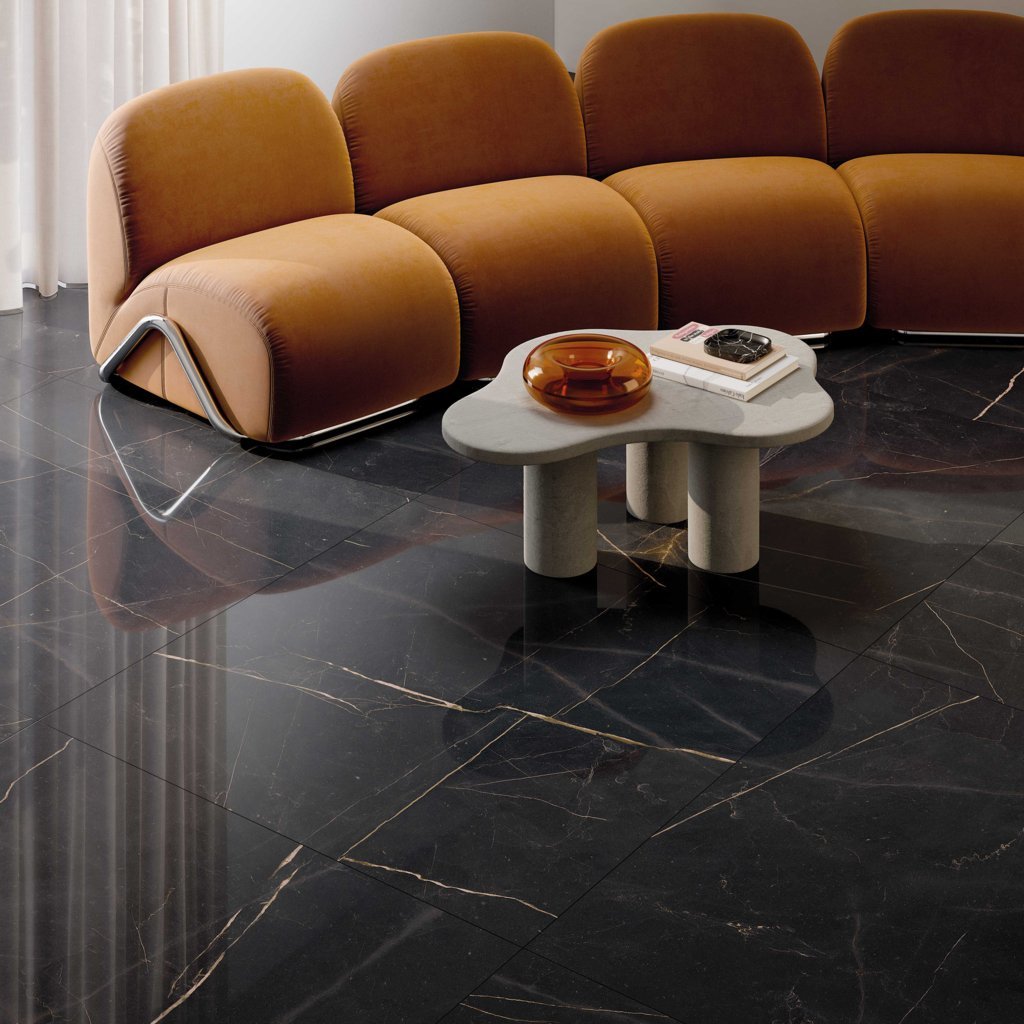
Pictured ABK Sensi 900 Precious Black polished unglazed 120x120cm
Lappato or semi-polished tiles
Lappato tiles are semi-polished finish tiles with a higher gloss level than matt tiles but lower than traditional polished tiles. Lappato is an Italian word meaning ‘semi-polished’. It refers to a technique in which the lightly textured surface of the tile is polished to about 0.1 mm of its top surface, the so-called ‘peaks’ of the tile structure. The surface of the tile remains polished in the higher part and matted in the lower part, resulting in a play between the gloss and the matted surface depending on the angle of view. As the angle of view changes, the surface either becomes glossy or matte. Thus, Lappato tiles are characterised by a beautiful transition from glossy areas to matt. There is no need to impregnate tiles with the Lappato finish. Unglazed porcelain, with a lappato or lightly polished finish, has a slip resistance rating somewhere between polished and matt.
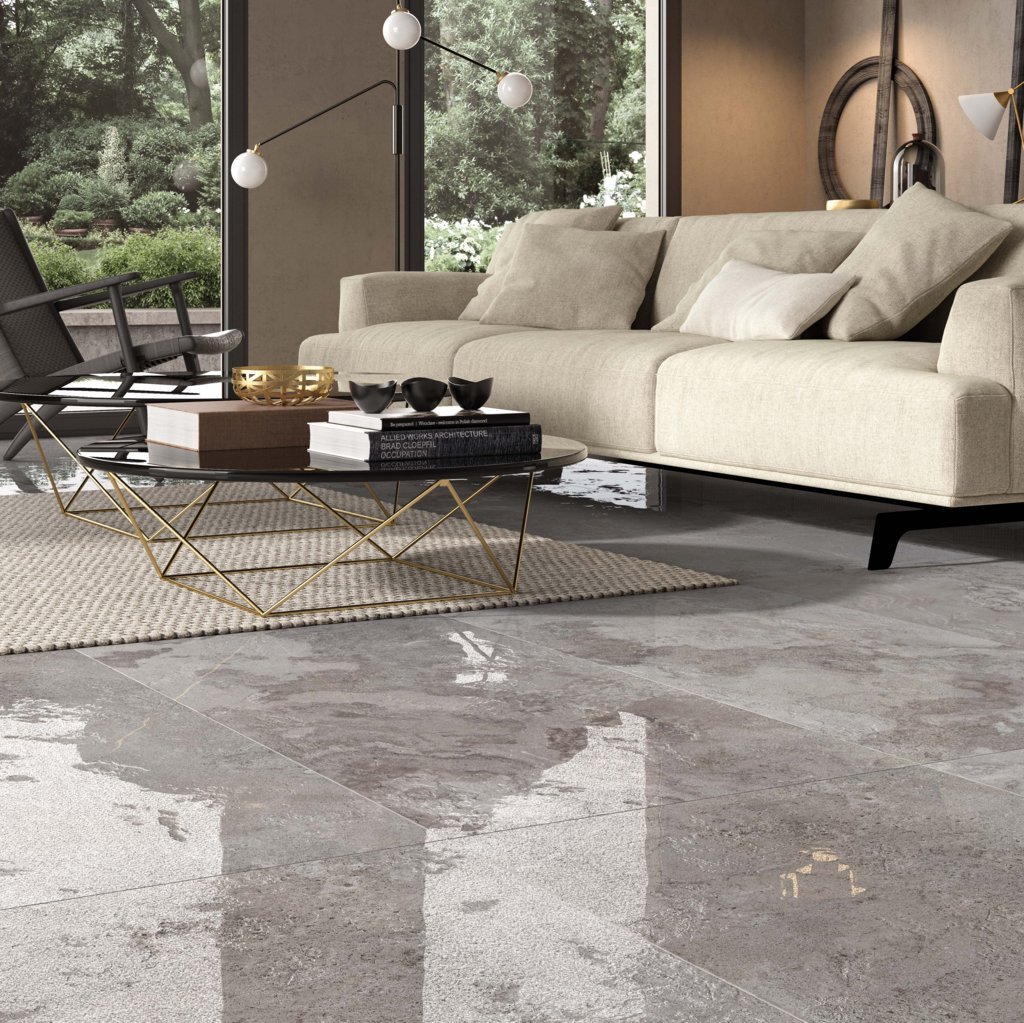
The picture shows ABK Alpes Raw Lead lappato semi-polished 60x120cm ceramic tiles.
Glazed porcelain tiles
In the case of glazed porcelain tiles, a layer of glaze is added to the surface of the tile before it is fired, hence these tiles are also referred to as ‘glazed porcelain tiles’. The glazed surface is created during the manufacturing process by adding liquid glass to the clay body of the tile prior to firing. Despite the fact that liquid glass is added to the surface of the tile during the production process, the surface of glazed porcelain tiles is not only glossy. Glazed porcelain tiles can be glossy, matt, lappato or textured. Since only the top layer of the tile is shade finished, the production process for these tiles is slightly cheaper. This fact makes these tiles a slightly cheaper and more attractive solution for the consumer.
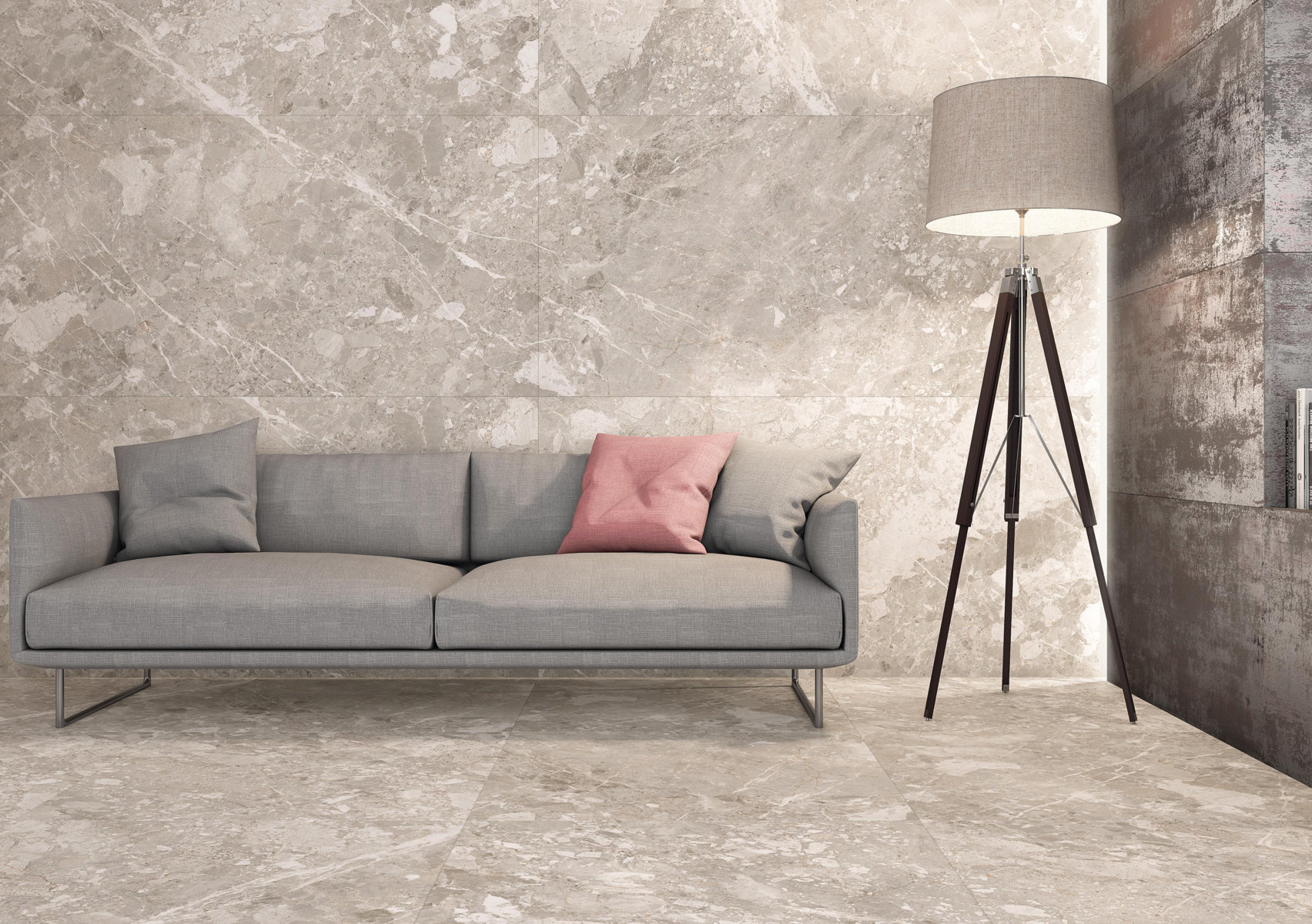
The picture shows TAU Belcastel 90x180cm ceramic tiles on the floor and the background wall and TAU Corten 60x120cm ceramic tiles on the right wall.
In addition to the finish, porcelain tiles are further classified into four groups according to their construction.
The porcelain tiles are available in the following types: solid porcelain, porcelain with a tinted base, porcelain with a double layer and porcelain with a white base.
Full body tiles
Full body tiles are tiles with a surface pattern and tone that runs through the body/cross-section/thickness of the tile. Solid body tiles are ideal for use in medium to high traffic areas in public buildings as well as in the home. Through slab is the best solution for heavy commercial, public and industrial areas. Through slabs are used in shops, schools, airports and 2-3 cm thick solutions for public pavements, public transport platforms, etc. For surfaces where a particularly high level of durability and wear resistance is required, permeable tiles are the best choice. For domestic use, perforated tiles are suitable for practically any application – ideal for living rooms, kitchens, corridors, terraces, worktops, as well as bathrooms, both on floors and walls. Thicker 2 cm solutions are suitable for outdoor patios, walkways etc. Solid slabs can be considered as one of the most durable flooring materials. Compared to, for example, natural granite, natural granite slabs are about twice as hard. As the design and colour of the slabs are the same throughout, they are particularly resistant to wear and tear and have a long life. Technical properties such as durability, water absorption and density, in addition to design and colour, are also uniform throughout the slab. Our range of diagonal tiles includes a range of designs and a wide range of sizes from the Italian company ABK Ceramiche. ABK Ceramiche offers good quality and innovative solutions at reasonable prices.
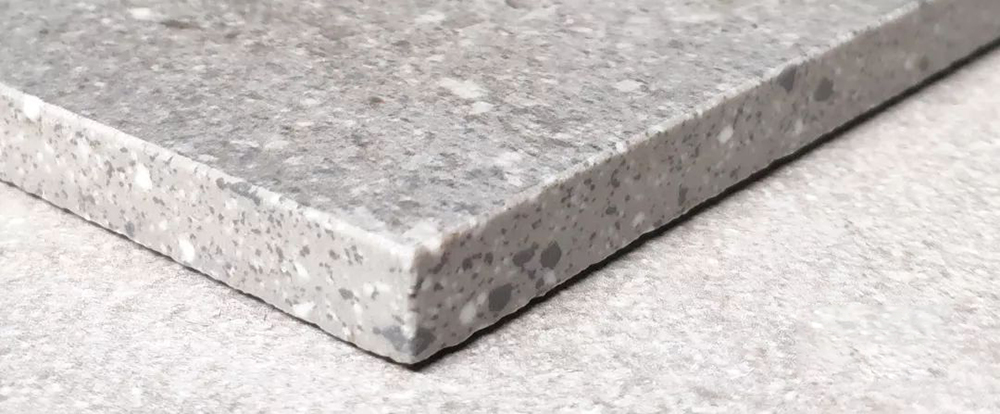
Full Coloured Body Porcelain Tiles Full Coloured Body
Porcelain Tiles refer to a solution where the base/body/cook of the tile is tinted in the same shade throughout the cross-section/thickness of the tile. Colour pigments are added to the tile mix to ensure that the body of the tile matches the colour of the tile surface. However, in this solution, the design in the base of the tile is not identical to the design on the surface. A porcelain tile with a tinted substrate offers additional security compared to a porcelain tile without a tinted substrate in the event of infrequent damage/wear of the glazed surface or particularly high load wear. In this case, the damage/wear is not noticeable as the tile substrate is the same colour as the tile surface. This fact makes porcelain tiles with a tinted substrate suitable for medium-load public areas such as commercial premises, offices, etc. For domestic use, it is suitable for practically anywhere.
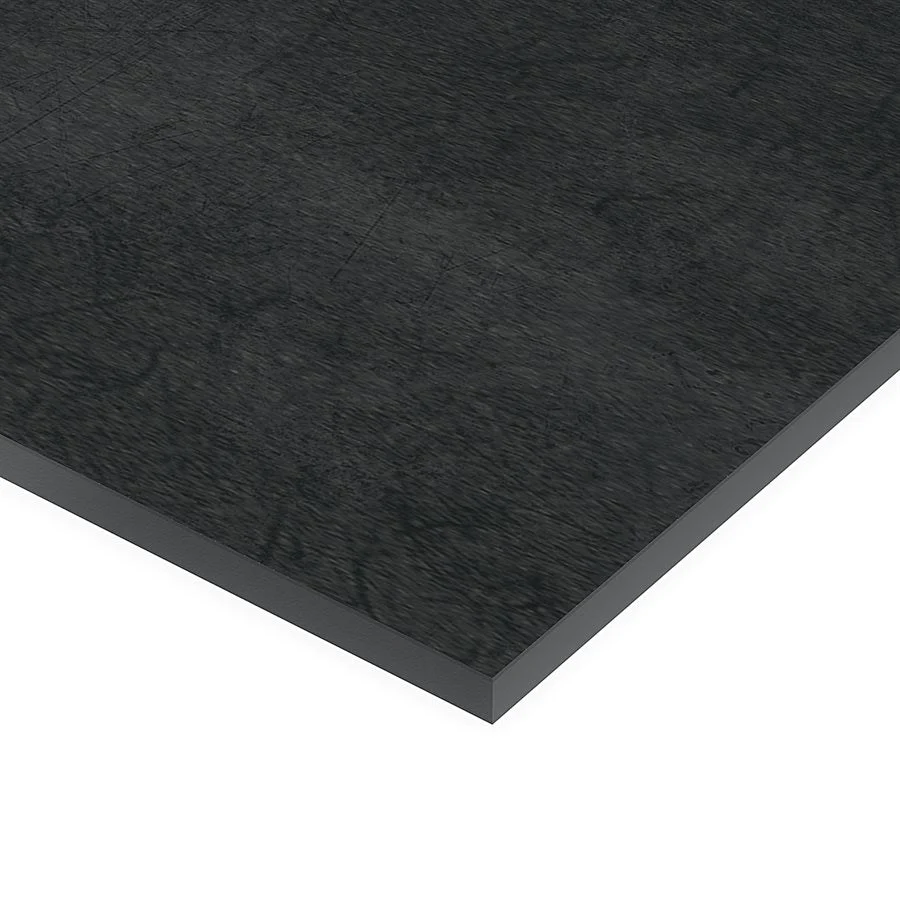
Double Loaded Porcelain Tiles
Double Loaded Porcelain Tiles are composed of two distinct layers – a top layer of approximately 3 mm of finish, consisting of a diameter, and a base layer of plain, untinted porcelain, which is distinct in tone and finish. The two layers are pressed together under high pressure. After pressing, the tiles are heated in the kiln at a high heat to form a single tile, the top layer of which prevents surface damage that could expose the base layer, thus offering first-class diamond tiles at a lower price level than through tiles. This solution is advantageous as any scratches or light wear will not reveal the different shade of the undercoat, while the cost of this solution is significantly lower compared to the price of a through-plate. This makes double-layer porcelain tiles very suitable for public areas that receive higher than normal loads, such as lobbies, shopping centres, etc.
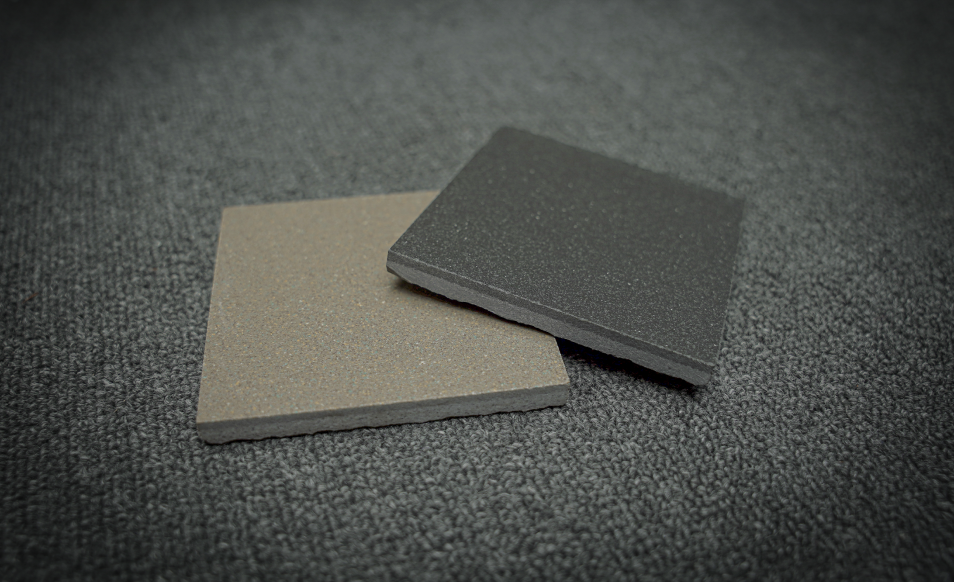
Off-White Body Porcelain Tiles
Off-White Body Porcelain Tiles refer to a solution where the design and colour are only on the surface of the tile, while the rest of the tile cross-section/thickness is made up of untinted and light-coloured porcelain. This is a glazed surface solution, similar to tinted base tiles. With this solution, unique and beautiful designs can be created which are protected by a layer of glaze, ensuring that the tiles are resistant to wear. The durability of glazed tiles can be verified by the PEI (Porcelain Enamel Institute) rating. While the construction of porcelain tiles with an untinted substrate is as durable and frost-resistant as the other porcelain tile types, they are suitable for installation in areas where light to moderate social loads are expected, in areas where there will be less abrasive dirt. They are also suitable for use in light commercial areas, such as office reception areas, but not in high-traffic areas such as entrances to shopping centres, etc. In the home, like other porcelain tiles, they can be used almost anywhere – in living rooms, hallways, kitchens, bedrooms, corridors, balconies, backsplashes, worktops and bathrooms, on both floors and walls.
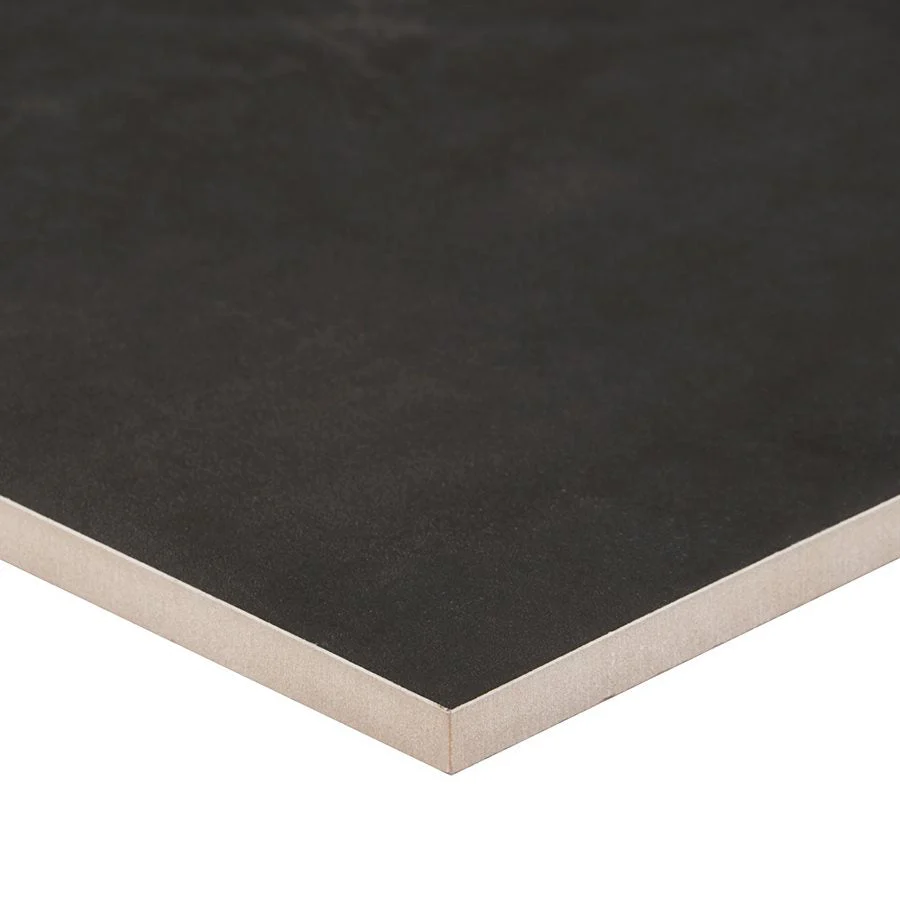
3. Clinker tiles
Clinker tiles are made from clay and various minerals which are pressed together under high pressure and then baked at temperatures of around 1000-1100 °C. During the baking process, the iron particles in the tiles are converted into hematite, giving the tiles their naturally characteristic red or reddish-brown colour. Nowadays, in addition to red or reddish-brown, grey, etc. are also available. Shades, which are achieved by adding colour pigments. Clinker tiles are inherently dense, withstand cold well and have a water absorption of less than 2%. These tiles are a very good solution for outdoor use, as most manufacturers’ ranges also have structural non-slip solutions pressed into the tile, profiles for steps, corner elements, etc.
